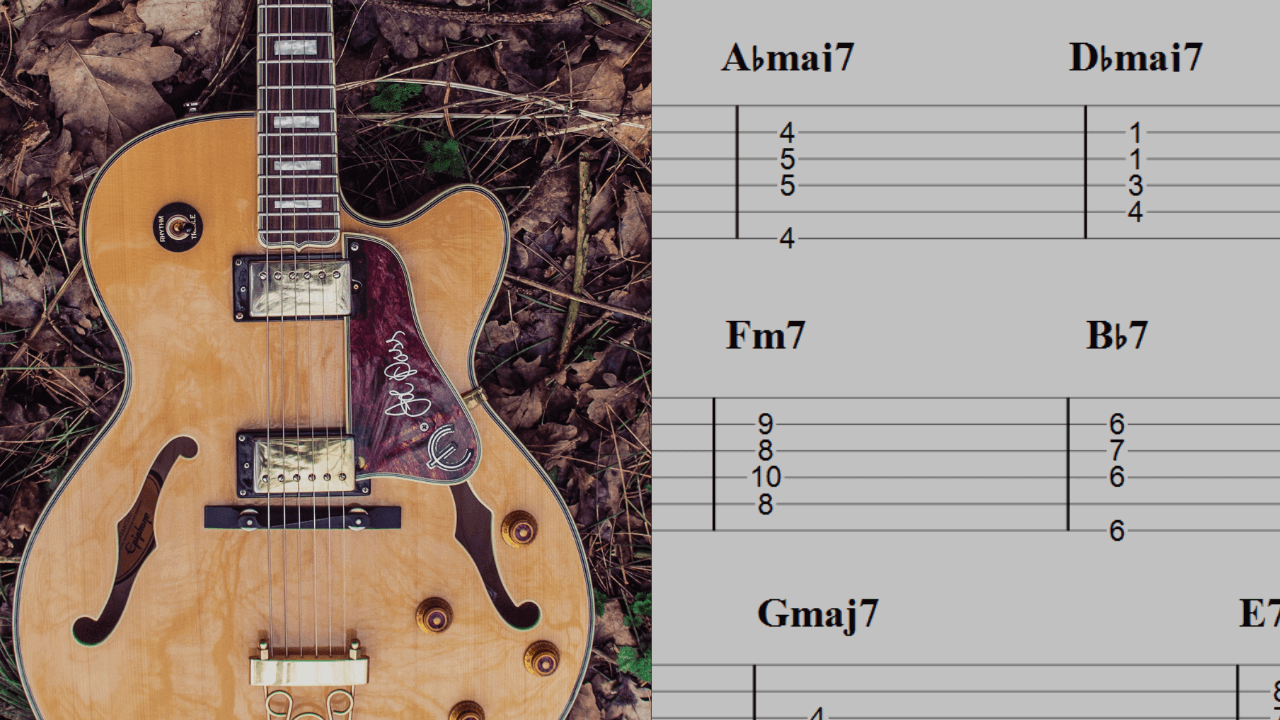As a budding musician, understanding the DNA of a song is paramount.
The backbone of any tune, regardless of genre, leans heavily on chord progressions, making additional elements such as melody, rhythm, and lyrics possible.
Today we delve into some of the most frequently used progressions in popular and classical music.
By grasping these basics, you’ll be well-equipped to create your own music or effortlessly play along with your favorite tracks.
In this article, we’ll break down these essential building blocks.
Table of Contents
- Common Chord Progressions
- I-IV-V (1-4-5)
- ii-V-I (2-5-1)
- I-IV-V-IV (1-4-5-4)
- I-V-vi-IV (1-5-6-4)
- I-IV-ii-V (1-4-2-5)
- vi-IV-I-V (6-4-1-5)
- I-vi-IV-V (1-6-4-5)
- I-ii-V-I (1-2-5-1)
- IV-I-IV-V (4-1-4-5)
- ii-V-I-IV (2-5-1-4)
- I-IV-vii°-iii (1-4-7-3)
- I-vi-ii-V (1-6-2-5)
- I-IV-V-vi (1-4-5-6)
- IV-V-iii-vi (4-5-3-6)
- I-V-vi-iii (1-5-6-3)
- vi-ii-V-I (6-2-5-1)
- I-iii-vi-II (1-3-6-2)
- IV-V-I-IV (4-5-1-4)
- I-V-ii-IV (1-5-2-4)
- I-vi-iii-IV (1-6-3-4)
- IV-V-I-vi (4-5-1-6)
- The Bottom Line
Common Chord Progressions
I-IV-V (1-4-5)
A versatile foundation for countless hits, this progression is key.
The I-IV-V progression, also known as 1-4-5, is one of the most widely used chord progressions in popular music genres like pop, rock, and blues. It is founded on the first, fourth, and fifth notes of a musical scale, offering a simple and pleasing tonal quality that is appealing to the ear.
- Difficulty: Easy
- Example: G – C – D (Key of G major)
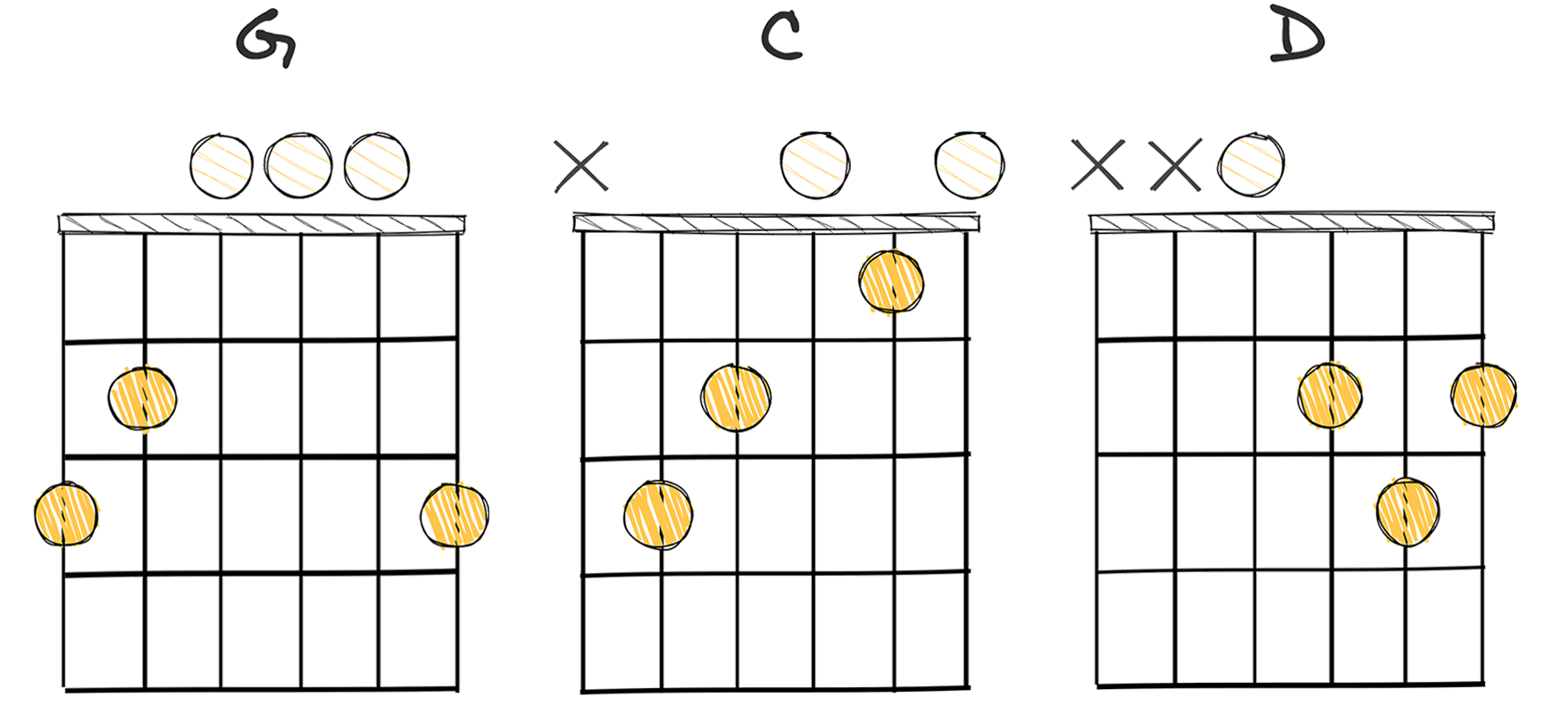
The I-IV-V (1-4-5) chord progression is a pivotal lynchpin in the world of music, found in genres spanning from classical to contemporary pop.
By tracing its roots back to the very genesis of harmonic music, we realize how deeply ingrained this progression’s history is in our collective musical culture.
It plays a prominent role in a swath of famous compositions, spanning across time and genres, reinforcing its place as a musical constant.
Backing this claim, let’s consider its prevalence in famous pieces.
Furthermore, the I-IV-V progression’s versatility makes it a valuable tool for songwriters, capable of carrying both upbeat, fast-paced numbers and slower, more emotionally charged pieces.
This chord progression’s simplicity and versatility make it a ‘must-know’ for any musician.
Indeed, learning to exploit this progression can open up a new world of possibilities for the creative artist, with countless songs created from its simple, yet powerful, structure.
Understanding this progression is not just about knowing a series of chords, but about appreciating their historical significance, understanding their ubiquity, and harnessing their simplicity for musical expressivity.
Every musician, whether amateur or professional, must understand and know how to use the I-IV-V chord progression, for it continues to be one of the most enduring and powerful tools in the world of music creation.
ii-V-I (2-5-1)
The backbone to countless jazz and pop classics.
The ii-V-I progression is a classic and ubiquitous chord sequence frequently found in a variety of music genres, especially jazz. This progression is greatly favored by musicians for its smooth ‘circle of fifths’ transition which often serves as a backbone in a song, providing a satisfying resolution and melodic structure.
- Difficulty: Easy
- Example: Em – A – D (Key of D major)
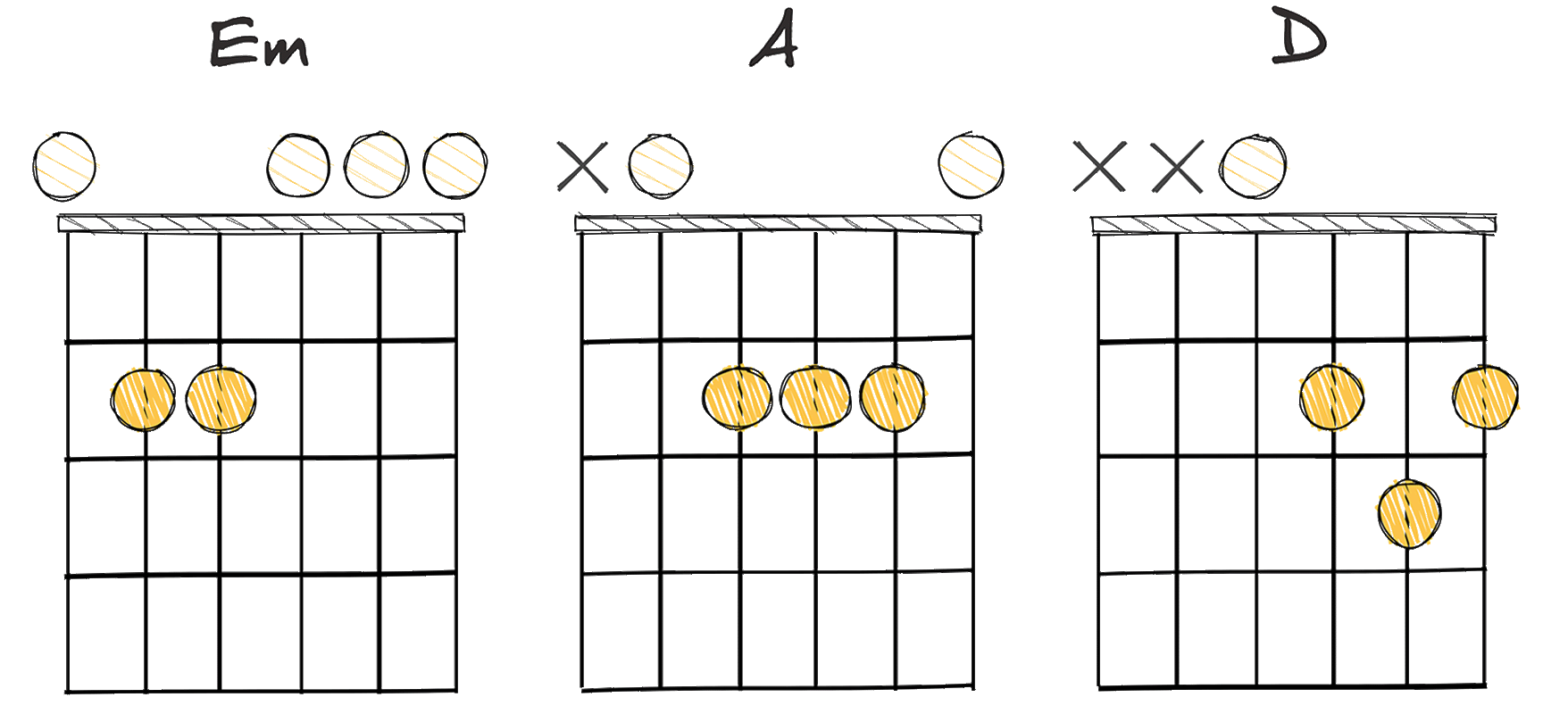
The ii-V-I (2-5-1) chord progression is a remarkable staple in music theory.
It’s a progression that has been used since the inception of music theory itself and continues to be prevalent in today’s music.
This progression is quite easy to play and lends itself magnificently to a variety of musical genres from jazz to pop.
Originating from classical music theory, it is a progression that carries with it a sense of resolution, making it a popular choice for composers and songwriters alike.
One fascinating aspect of the ii-V-I progression is its inherent flexibility.
It can be used as a standalone progression or as part of a larger progression to add color and complexity to the musical piece.
Its flexibility doesn’t just stop at the inclusion in larger progressions.
It can be tweaked and rehashed to suit a particular musical vision, further enhancing its versatility and ubiquity across music genres and styles.
Take, for example, the chord progression Em-A-D in the key of D major.
It’s simple, yet it encapsulates the beauty and elegance of the ii-V-I progression.
While this might seem elementary, how it’s utilized can drastically change the mood and flavor of a song.
The ii-V-I progression’s eloquence and simplicity make it a favorite among music educators, often serving as an introductory lesson in chord progressions.
It is a great tool for teaching budding musicians about the principles of tension and resolution in music theory.
Even musicians with limited music theory knowledge can grasp the structure and reasoning behind the progression.
It’s clear and concise, with each chord naturally leading into the next, making it an excellent starting point for beginners.
The prevalence of the ii-V-I progression in popular music is extraordinary.
You can trace its usage in countless hit songs across multiple genres and decades.
Its universal appeal and flexibility have cemented its place in musical history.
Above all, the ii-V-I chord progression continues to be a mainstay in music theory due to its elegance, simplicity, and ability to evoke a complex range of emotions.
Whether it’s used as the foundation for a song or inserted into a larger progression for added depth, the ii-V-I’s impact is undeniable.
The ii-V-I chord progression’s history, simplicity, and utility make it a worthwhile element of music theory to master.
I-IV-V-IV (1-4-5-4)
The I-IV-V-IV: the fundamental, catchy backbone of classic rock tunes.
The I-IV-V-IV progression is a staple in multiple genres of music due to its tonal stability, and the pleasant mood it creates. It’s commonly used in pop and rock music and is celebrated for its simplistic harmony, making it a must-learn for budding musicians.
- Difficulty: Easy
- Example: G – C – D – C (Key of G major)
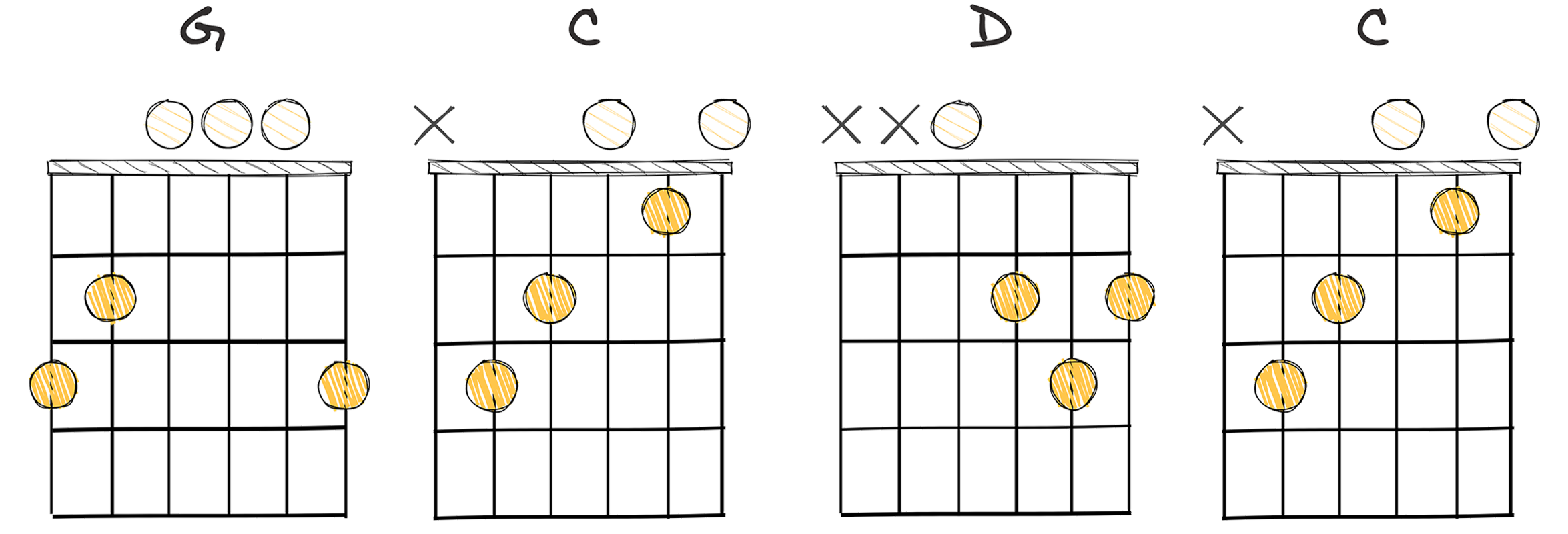
In studying music, you’ll come across a plethora of chord progressions.
However, there’s one chord progression that’s notably simple to grasp and yet fundamental to a wide range of music: the I-IV-V-IV progression, or in the key of G Major: G – C – D – C.
This chord progression truly shines in its versatility.
Its sequence of chords ensure a pleasant and uplifting resolution, inherently tying the song’s framework together.
It’s relatively straightforward to build a melody over this progression, which explains its widespread presence in a diverse range of music styles.
The I-IV-V-IV chord progression has its roots deeply planted in Western music history.
As a cornerstone of the common practice period, this progression has been fulfilling harmonic functions for centuries, highlighting the tonic, subdominant, and dominant chords in a unique order.
Remarkably, this chord progression is both comfortable to play and melodically intriguing.
Its simplicity is what makes it a perfect starting point for aspiring musicians learning to construct their own melodies and inject their unique flair into a given piece of music.
The I-IV-V-IV chord progression has been adopted in a multitude of music genres like pop, rock, country, blues, and beyond.
These genres depend heavily on this progression for defining their characteristic sounds.
This progression effectively balances predictability and surprise, to facilitate melody creation and offer a broad, sonorous base.
Indeed, the I-IV-V-IV progression’s accommodating nature makes it the heart of great compositions.
Its predictability delivers comfort and familiarity, while its ability to introduce surprising melodic jumps and rhythmic changes keeps listeners engaged.
Moreover, its fundamental nature makes it an ideal progression for learning functional harmony—understanding the roles different chords play within a tonality, and how they relate to each other.
The I-IV-V-IV progression is straightforward, versatile, meaningful, and has a rich historical background that validates its widespread usage in various music genres.
Understanding how to play this progression and studying its application in different music styles will significantly improve any musician’s songwriting and performance skills.
I-V-vi-IV (1-5-6-4)
This ubiquitous progression lays the foundation for countless pop songs.
The I-V-vi-IV progression is a popular sequence of chords often used in various genres that provides a pleasant, uplifting, and repetitive melodic structure. This progression effectively creates a sense of familiarity and emotional resonance, making it critical for budding musicians to understand and utilize.
- Difficulty: Easy
- Example: C – G – Am – F (Key of C major)
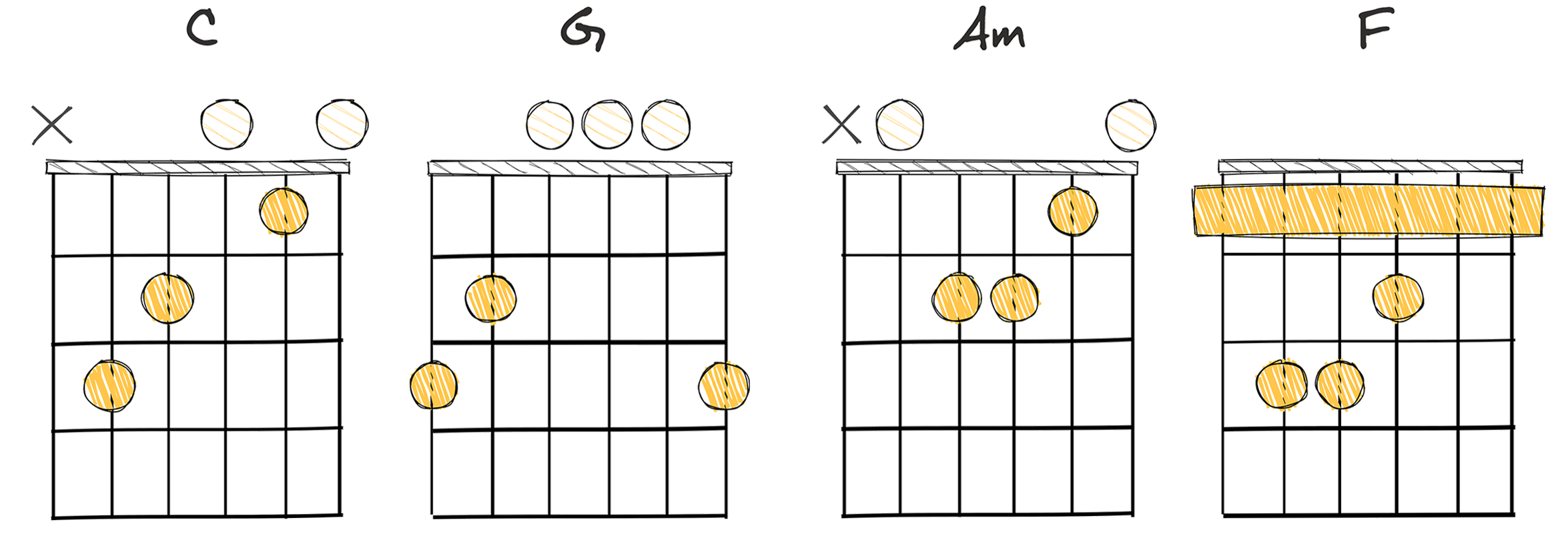
The chord progression of I-V-vi-IV (1-5-6-4) is effectively an integral part of developing music as it provides harmonic foundation to a lot of the melodies we know today.
The I-V-vi-IV progression has a rich history in popular music and has proven to be a timeless and versatile structure.
It is known for being easy to play and is often used as a stepping stone for beginners who are learning to play guitar, piano or other instruments.
The premise of the I-V-vi-IV progression is centered around the primary triads (major and minor chords) in a key.
The sequence retains the tonality of the original root note throughout the progression, leading to an interesting harmonic tension and resolution.
This chord progression, I-V-vi-IV, can be found in many popular songs across various genres, making it a common and familiar sound to most listener’s ears.
Its universal appeal can be partly attributed to its simple yet effective chord sequence that simultaneously grounds the listener while providing an uplifting melodic framework.
When it comes to playing these chords, one of the primary reasons it is considered easy to play is because of the minimal movement required between chords.
In the key of C Major, for instance, the chords used in this particular progression are C – G – Am – F.
This key is one of the first that many musicians learn because it doesn’t require complicated fingering or shifting positions on the frets or keyboard.
For beginning guitarists, the chord shapes for C, G, Am, and F preserve their forms and require only small shifts in finger placement, a factor that helps reinforce the learning process and expedite mastery.
Moreover, the I-V-vi-IV progression is not exclusive to pop+.
A myriad of blues, rock, country, and even jazz songs utilize this progression, demonstrating its wide adoption in diverse musical landscapes.
While it’s not the only chord progression out there, the I-V-vi-IV progression undoubtedly occupies a significant place in the landscape of popular music.
Hence, knowing how to play and recognize this chord progression can serve as a crucial step for aspiring musicians and serves to enrich the understanding and appreciation of music for listeners.
Furthermore, it can also be the building block for expanding into different chord progression variants, enhancing one’s musical repertoire and creativity.
The I-V-vi-IV progression clearly proves that sometimes simplicity is key, and a basic structure can pave the way for an endless variety of musical expressions.
In the realm of music theory and practice, the understanding and application of this progression can open up a world of opportunities for both nascent and accomplished musicians.
I-IV-ii-V (1-4-2-5)
This progression provides a simple, memorable foundation for countless hits.
The I-IV-ii-V chord progression is a frequently used sequence in various genres of music, especially in jazz and pop, due to its pleasant resolve and catchy tune. It employs the use of four chords based on the first, fourth, second and fifth notes of a scale, creating a cycle that can either repeat or lead back to the initial chord, offering a diverse range of harmonic possibilities.
- Difficulty: Easy
- Example: G – C – Am – D (Key of G major)
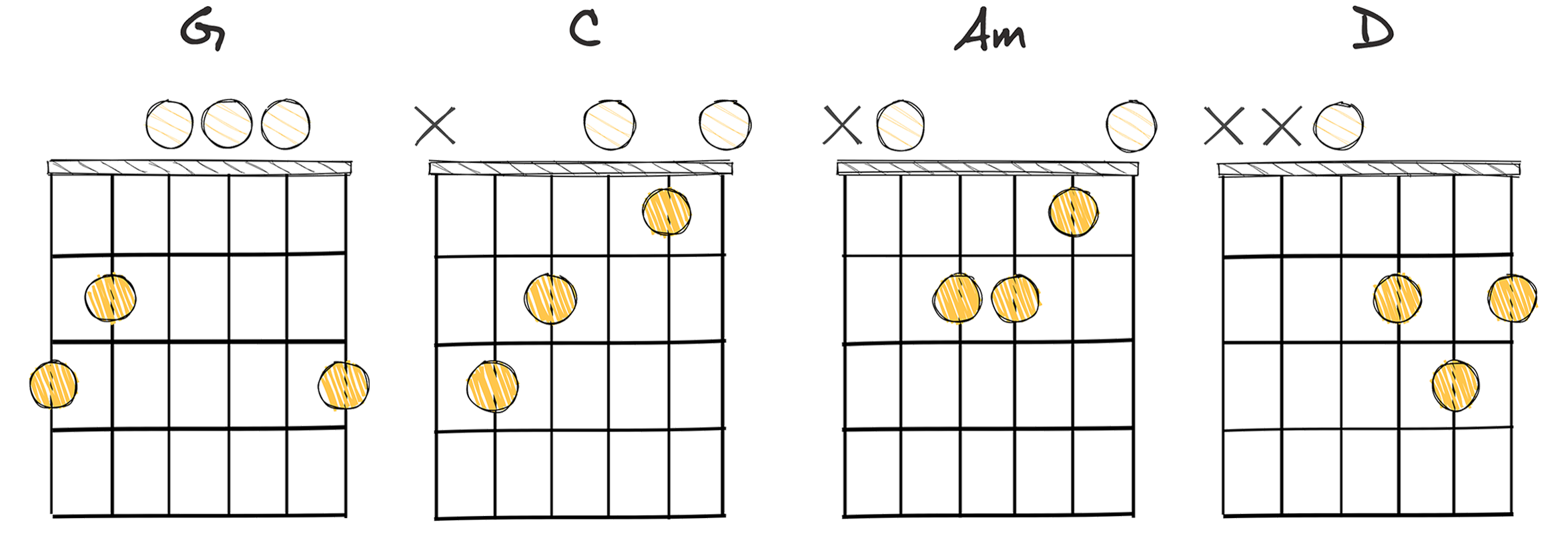
In this section, we will be exploring the chord progression I-IV-ii-V (1-4-2-5).
This progression has a rich history in the world of music, with several artists and composers applying it in their recordings throughout the years.
It’s important to appreciate that this progression is relatively easy to play.
It allows for a smooth transition between chords, making it a favorite for many musicians.
The simplicity and musicality of this progression lead to its widespread use in different genres, adding to its popularity and ubiquity in music.
The chord progression is also often used cyclically, recurring throughout the song and serving as the foundational harmony for the melody.
Using chords in the key of G Major as an example, the progression translates to G – C – Am – D.
Playing these chords in sequence often lends a song a kind of harmonic fullness and satisfying resolution, contributing to its appeal among composers and listeners alike.
In terms of composition, the I-IV-ii-V progression offers a balanced musical journey.
The movement from the tonic to the subdominant provides a pleasant shift, the transition from the subdominant to the supertonic introduces tension, and the resolution through the dominant back to the tonic completes the cycle.
It’s always beneficial to actively listen to songs with this progression to enhance your understanding and application.
Note that even within the same progression, different genres and artists will inject their unique styles and embellishments.
On a final note, it’s crucial to understand that while chord progressions like I-IV-ii-V are fundamental, creativity and personal style are key to making music that stands out.
Remember, it’s not just about the chords you play, but how you play them.
vi-IV-I-V (6-4-1-5)
A quintessential timeless progression often heard in popular hit songs.
The vi-IV-I-V chord progression is an incredibly popular sequence in the music world, often used in a variety of genres due to its pleasing resolution from the relative minor (vi) to the tonic (I). This versatile progression creates an infectious rhythm, offering a sense of completion when looped, making it ideal for pop, rock, and country songs.
- Difficulty: Easy
- Example: Am – F – C – G (Key of C major)
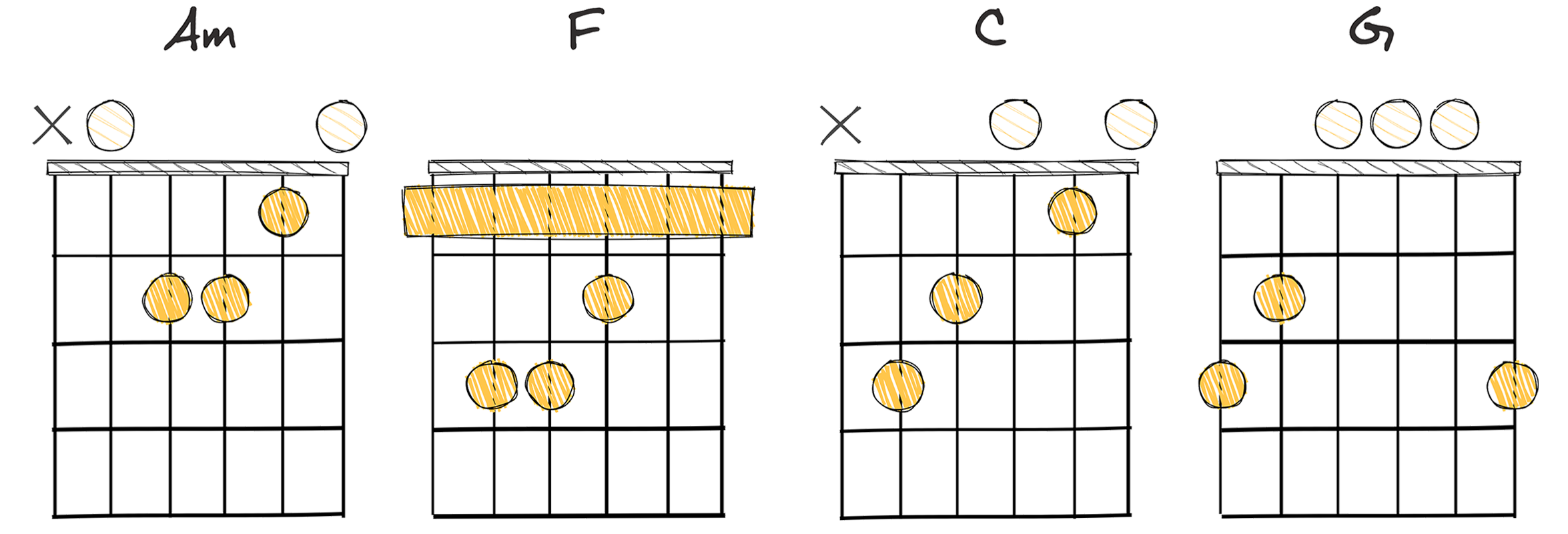
In the realm of music theory, chord progressions are a fundamental concept that every budding musician should master.
Among these, the vi-IV-I-V program, numbered 6-4-1-5 in the Nashville number system, is both common and remarkably versatile.
The progression is often employed in pop music to generate an uplifting and catchy melody that resonates with the listener.
This progression finds its roots in common practice period music, implicitly weaving our experiences and expectations of harmony.
This period covers music from Baroque, Classical, and Romantic eras, where many chord progressions generated then still bear strong influence on today’s pop and rock music.
In the process, the 6-4-1-5 progression became a staple in the songwriting toolkit.
The 6-4-1-5 progression is popular because it’s easy to play.
The progression maintains a strong foundation in many songs while exploring the tension-release dynamic.
This dynamic is why it’s commonly found within the genre of pop music.
One significant feature of this common chord progression is the balance it portrays between stability and tension; it starts with relative minor for a more mellow tonality (vi), raising to IV and I for stability, and finally shifting to V for tension before resolving back to I in the next cycle.
Suitable usage of this chord progression brings a compelling depth to an otherwise simple melody.
The dashes of tension and release it offers make it appealing to both the listeners and the musicians.
On a keyboard, switching between these chords is fairly simple.
That’s another reason why this chord progression is popular amongst beginners and songwriters.
You can quickly play and sing along to your favorite songs using this progression with minimal variation in hand movements.
Ultimately, understanding the 6-4-1-5 chord progression is an impressive way to expand your musical knowledge.
It’s a useful tool for composing memorable accompaniments and allows for plenty of room for creative reharmonization.
Across styles and genres, the 6-4-1-5 chord progression continues to be a potent narrative device in the hands of adept songwriters.
The beauty of this progression lies in its simplicity, and its capacity to be molded into various musical aesthetics proves its versatile influence in music theory.
So, for those starting their musical journey or even seasoned musicians looking to revisit the basics, revisiting this chord progression is highly worthwhile.
Creating an in-depth knowledge of these common chord progressions is sure to better your songwriting and musical comprehension.
I-vi-IV-V (1-6-4-5)
Central backbone to countless pop hits, evoking familiarity and nostalgia.
The I-vi-IV-V chord progression is a classic in western music, often seen in various genres like pop, rock, classical and jazz. Its structure begins in the tonal center, then travels to the relative minor, back to the sub-dominant and finally to the dominant, creating a satisfying, full circle journey.
- Difficulty: Easy
- Example: G – Em- C- D (Key of G major)
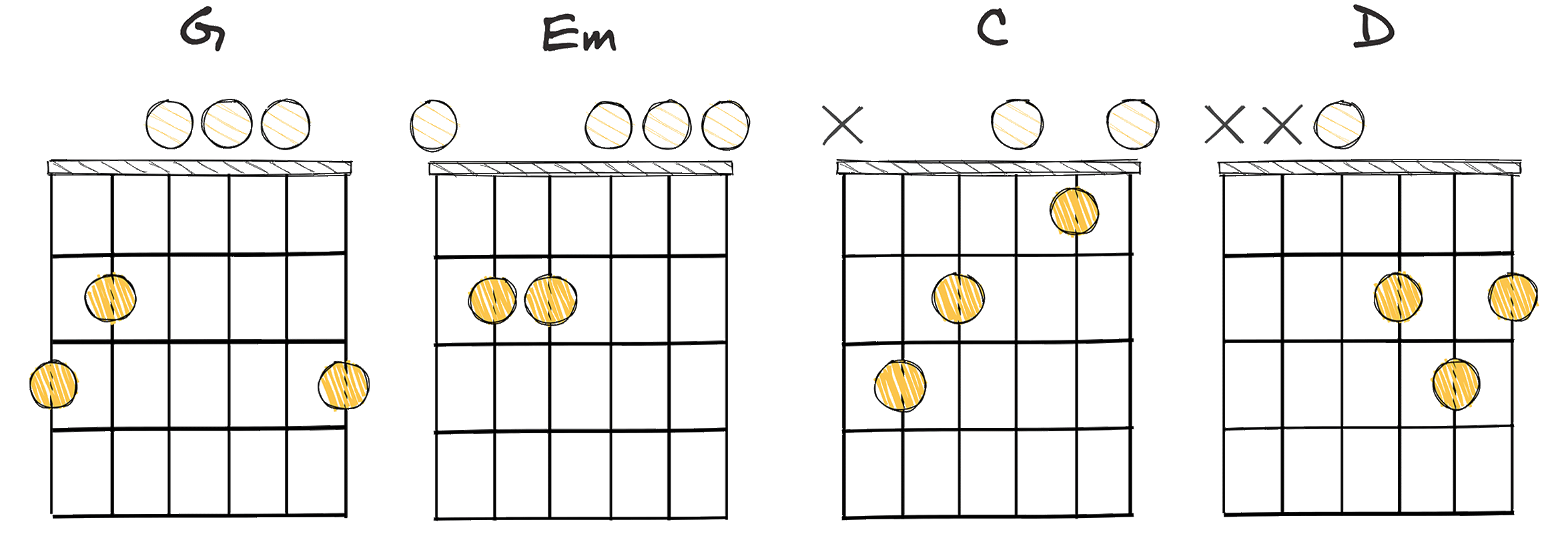
The I-vi-IV-V chord progression, or the 1-6-4-5 in numerical notation, is a sequence of chords that is quite common in many popular music genres.
This chord progression is considered one of the easiest to play, making it highly suitable for beginner musicians and songwriters.
In the key of G major, the chords G – Em- C- D represent the I-vi-IV-V progression.
The I-vi-IV-V progression is often appreciated for its emotional depth and versatility, giving it the ability to resonate with a wide array of listeners.
This progression can bring about a nostalgic or wistful feeling, qualities that give a unique flavor to the compositions in which it is used.
The emotional depth of the I-vi-IV-V progression can be altered by slight shifts in the rhythm and melody, providing almost limitless possibilities for song creation.
The history of the I-vi-IV-V progression goes back to the roots of Western music, having been consistently used throughout the Classical, Baroque, and Romantic eras.
It came to great prominence particularly in the 1950s and 1960s, underpinning many popular rock ‘n’ roll and doo-wop hits.
Its wide application in various eras and genres is a clear testament to its versatility and timeless appeal.
Learning to master the I-vi-IV-V progression is a fundamental step in any aspiring musician or songwriter’s journey.
So as you continue your musical learning journey, consider the I-vi-IV-V progression as a basic foundation and a powerful tool for creating memorable and touching musical pieces.
I-ii-V-I (1-2-5-1)
A cornerstone of jazz and pop, the I-ii-V-I progression is iconic.
The I-ii-V-I is a classic chord progression often used in jazz and pop music due to its easy-flowing transition and pleasurably resolved tension. This progression has a strong harmonic pull towards the home chord (I), creating a sense of cyclical motion that is useful for many musical genres.
- Difficulty: Easy
- Example: C – Dm – G – C (Key of C major)
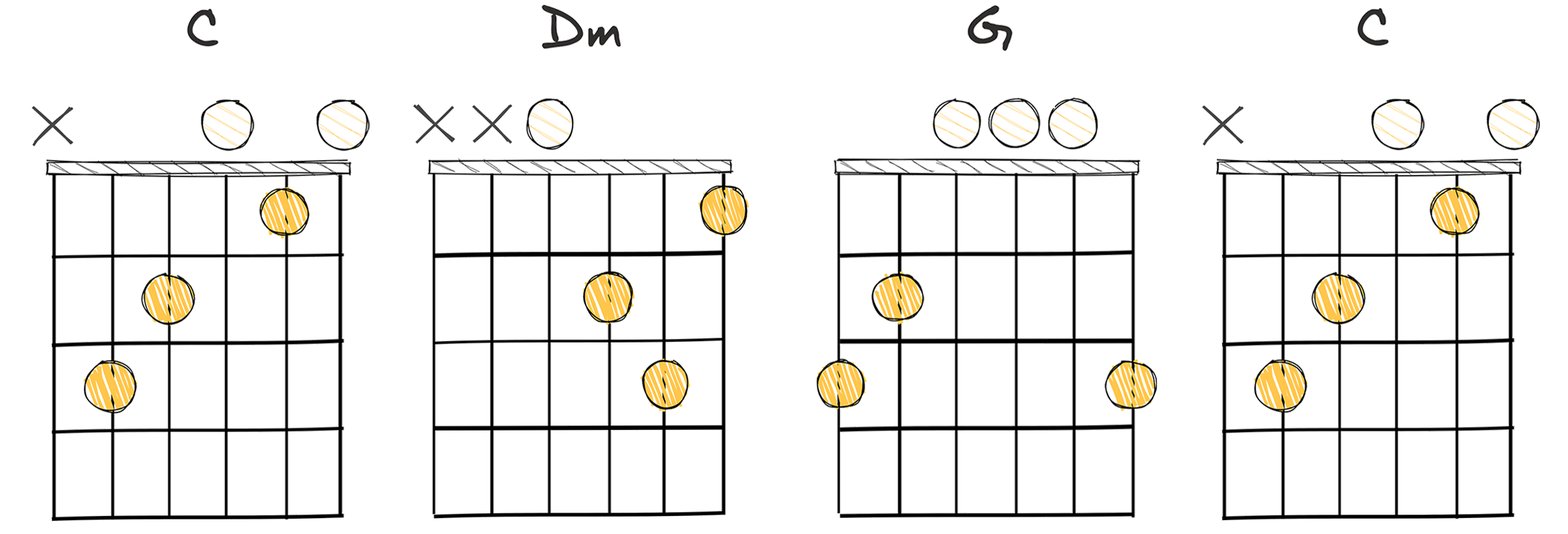
The I-ii-V-I chord progression, often known as the turnaround progression, is one of the most important and widely used progressions in all of music.
This time-honored sequence is a must-learn for any aspiring musician.
Its name might seem daunting, but the I-ii-V-I progression is actually pretty simple to understand.
It gets its name from the numerical system used to represent each chord in a major scale.
The I-ii-V-I progression can be found in countless songs across a wide array of genres.
Despite its simplicity, this progression has a rich history dating back to the birth of music theory.
The history of the I-ii-V-I progression can be traced back to the time of the Baroque period, around 1600-1750.
Its repetitive nature and predictable pattern were considered pleasing to the ear and therefore, it was used frequently in compositions back then.
The I-ii-V-I progression is often labeled as the beginner’s progression due to its ease of playability and understanding.
Addressing this statement, it’s safe to say that due to the fluid transition between the chords in the I-ii-V-I progression, it tends to be easier for beginner musicians to play accurately and consistently.
It is a sequence that is easy to master and offers an excellent foundation for learning more complex progression patterns.
Let’s take an example to understand this better.
If we are playing in the key of C major, the chords we would use in this progression would be C – Dm – G – C.
If you practice this for a while, you’ll find this chord progression is quite smooth on the fingers.
Understanding and mastering the I-ii-V-I chord progression is a vital part of becoming a skilled musician.
This versatile and easy-to-play progression is a cornerstone of many genres of music and serves as a great starting point for beginners.
So, whip out your instrument, be it a guitar, a piano, or something else, and give that I-ii-V-I progression a strum!
Remember, practice makes perfect, and with a little time and patience, this time-honored progression will become a go-to in your musical arsenal.
IV-I-IV-V (4-1-4-5)
A classic harmony sequence offering a retro feel and smooth transitions.
The IV-I-IV-V chord progression is a fundamental sequence in western music, often used in a variety of genres for its satisfying resolution and ‘full-circle’ feeling. Musicians consider this progression to be catchy, versatile, and easy to implement, making it a must-learn for any aspiring songwriter or composer.
- Difficulty: Easy
- Example: G – D – G – A (Key of D major)
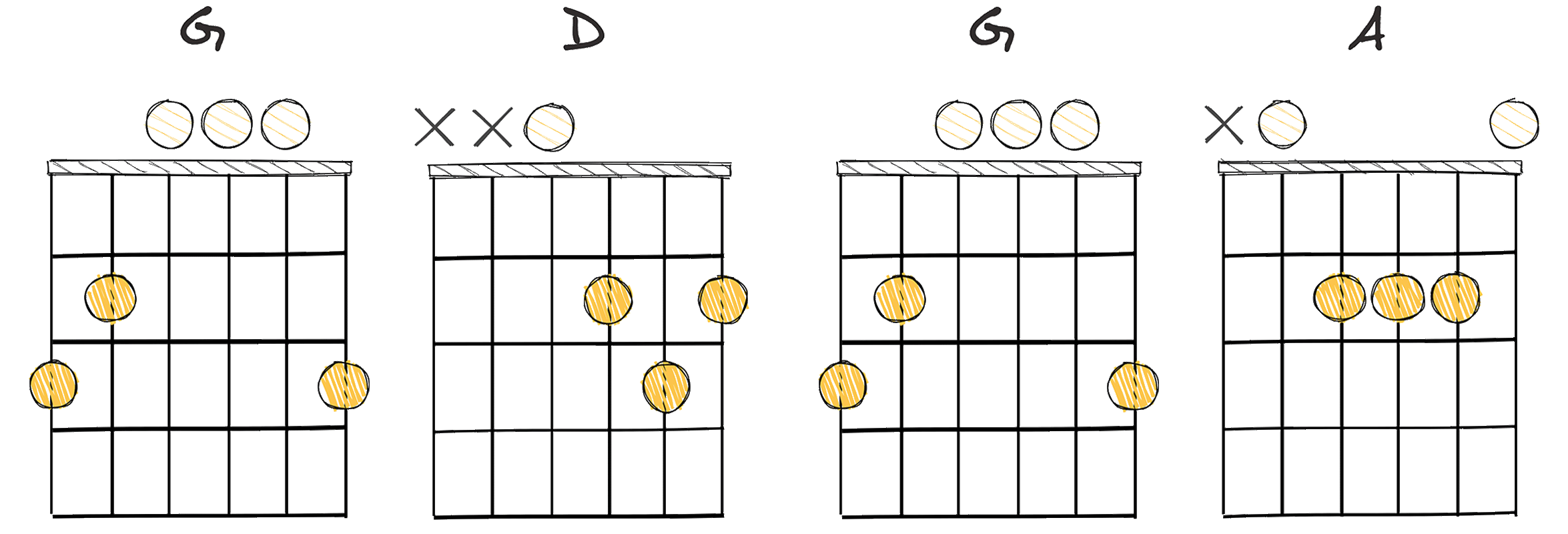
The IV-I-IV-V (4-1-4-5) chord progression is a popular chord sequence that is adaptable to many genres.
Popular in the 1950s and 1960s, the progression’s rich history and adaptable nature ensured its place in modern music as it is not genre-specific and can be found in blues, rock, pop and even jazz songs.
All these chords are easy to play, making this progression a crucial tool for beginners in their journey to understanding and mastering music theory.
This assertion holds because each chord simply requires a small movement of the fingers on the fretboard.
The ease of learning these chords helps beginners develop confidence and expand their repertoire rapidly.
Moreover, the sequential nature of the chords in the IV-I-IV-V progression helps the novice guitarist develop a keen understanding of the interplay between chords and the impact they have on the overall vibe of a song.
The G – D – G – A chords in the key of D major are also elevated by this progression, creating a classic sound that is integral to numerous hits.
In addition to its ease of execution, the IV-I-IV-V progression also lends itself to a variety of strumming styles and rhythm patterns, enabling a guitarist to create textured and nuanced interpretations of a song.
Furthermore, the transitions between the chords in this progression are often smooth and flowing, facilitating a seamless account of the melody that is often engaging and melodious.
Finally, it is important to remember that mastering this progression can drastically enhance one’s ability to perform and even compose music.
The innate simplicity and versatility of the IV-I-IV-V progression make it an indispensable tool in the arsenal of a musician.
It underscores the importance of learning not just individual chords, but also understanding how they interact with each other in a progression to bring music to life.
ii-V-I-IV (2-5-1-4)
This chord progression serves as the backbone to countless pop songs.
The ii-V-I-IV chord progression is a classic in western music, predominantly used in jazz, owing to its harmonious movement and resolution. This progression is a sequence of four chords with the second, fifth, and first chords in a given scale, followed by the fourth, creating a melodious cycle that’s commonly used for creating harmonious tunes.
- Difficulty: Intermediate
- Example: Dm – G – C – F (Key of C Major)

The ii-V-I-IV progression is a very popular chord progression that you will come across in many different genres of music.
Being an essential element of the modern musical lexicon, it has its root deeply set in the Jazz and Blues genres but has made its intriguing presence felt in Pop, Rock, Country, and even classical music.
Historically speaking, the ii-V-I-IV progression has been the basic framework of many popular songs and pieces, making it an important part of the musical landscape.
The ii-V-I-IV chord progression can be considered of intermediate difficulty to play, particularly when it comes to shifting between chords swiftly and smoothly.
The ii-V-I-IV progression is also considered great for practicing techniques like voice leading, an important skill to develop for aspiring musicians.
The ii-V-I-IV progression has a distinct characteristic that really sets it apart: it moves by falling fifths and rising fourths, creating a sense of resolution and completeness.
This movement helps in creating a cyclic musical pattern, providing fascinating harmonic potential for compositions and improvisations.
This cyclical nature has made it inherently pleasing to the human ear, and hence, it is embraced by musicians and listeners alike.
The ii-V-I-IV progression, when used in the key of C Major, involves moving from a D minor chord (ii), to a G Major chord (V), to a C Major chord (I), and finally to an F Major chord (IV).
The beauty of the ii-V-I-IV chord progression is that it can be used in various ways to enhance the overall mood of a composition.
Learning the ii-V-I-IV progression is a must for any aspiring musician or composer.
Its harmonically rich and versatile nature makes it a valuable tool in the hands of creative artists.
From Jazz, Blues, and beyond, the ii-V-I-IV progression continues to be a common and beloved progression in music.
I-IV-vii°-iii (1-4-7-3)
A harmonious journey from stability to tension and back again.
This I-IV-vii°-iii progression begins on the tonic chord and then transitions to a sub-dominant chord, providing a sense of uplift. It then descends to the diminished seventh for a touch of disruption, before landing on the mediant chord, adding a moody, somber touch to the overall effect.
- Difficulty: Intermediate
- Example: G – C – F#dim – Bm (Key of G major)
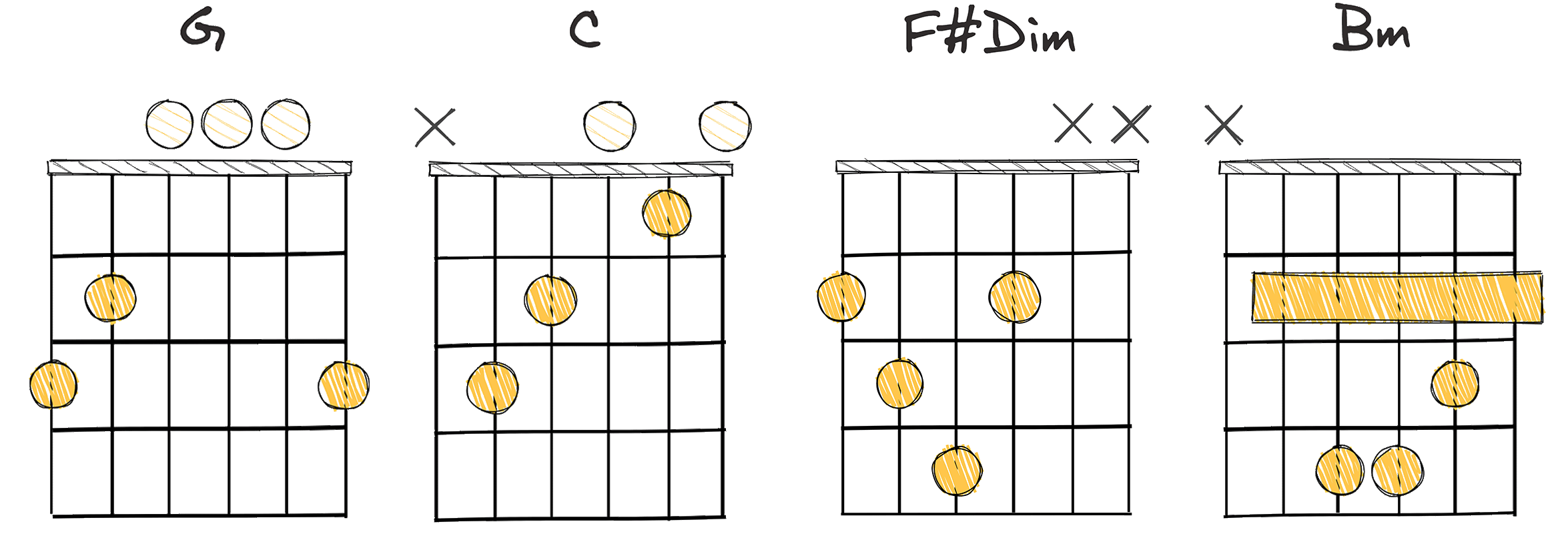
In the world of music theory, chord progressions stand as the pillar on which a song’s structure is built.
The chord progression I-IV-vii°-iii (1-4-7-3) is no exception.
This progression has been an essential part of creating magnificent works of music.
Basic understanding of chord progression is a much-needed tool for any intermediate musician.
Let’s delve into the chord progression I-IV-vii°-iii, an intermediate level progression that offers a fusion of tension and resolution.
The chord progression I-IV-vii°-iii, if translated into terms of musical notes in G major would be G – C – F#dim – Bm.
When a piece of music shifts from G to C and subsequently to F#dim, it creates an intriguing progression for the listeners.
The energetic chord change from C to F#dim introduces an element of tension, which is beautifully resolved when the chord progression moves from F#dim to Bm.
The resolution in the progression I-IV-vii°-iii engenders a feeling of completion for the listener.
It gives a much-needed pause and a sense of finality.
Though this chord progression has been used considerably in older music genres for its emotional characteristic, it continues to be a popular choice in modern music.
Delving into its history, progression I-IV-vii°-iii also had a significant place in classical music and baroque music.
They played a significant role in shaping major melodic structures.
Musicians found the progression I-IV-vii°-iii to be an excellent tool to bring out unexpected and delightful resolutions, hence its popularity.
I-vi-ii-V (1-6-2-5)
This popular progression forms the backbone of countless jazz standards.
The I-vi-ii-V chord progression, also known as the 1-6-2-5, is one of the most ubiquitous sequences in music, especially in Jazz. This progression, known for its smooth transitions and harmonious sound, is key to understanding many of the classic and contemporary songs across different genres.
- Difficulty: Easy
- Example: C – Am – Dm – G (Key of C major)
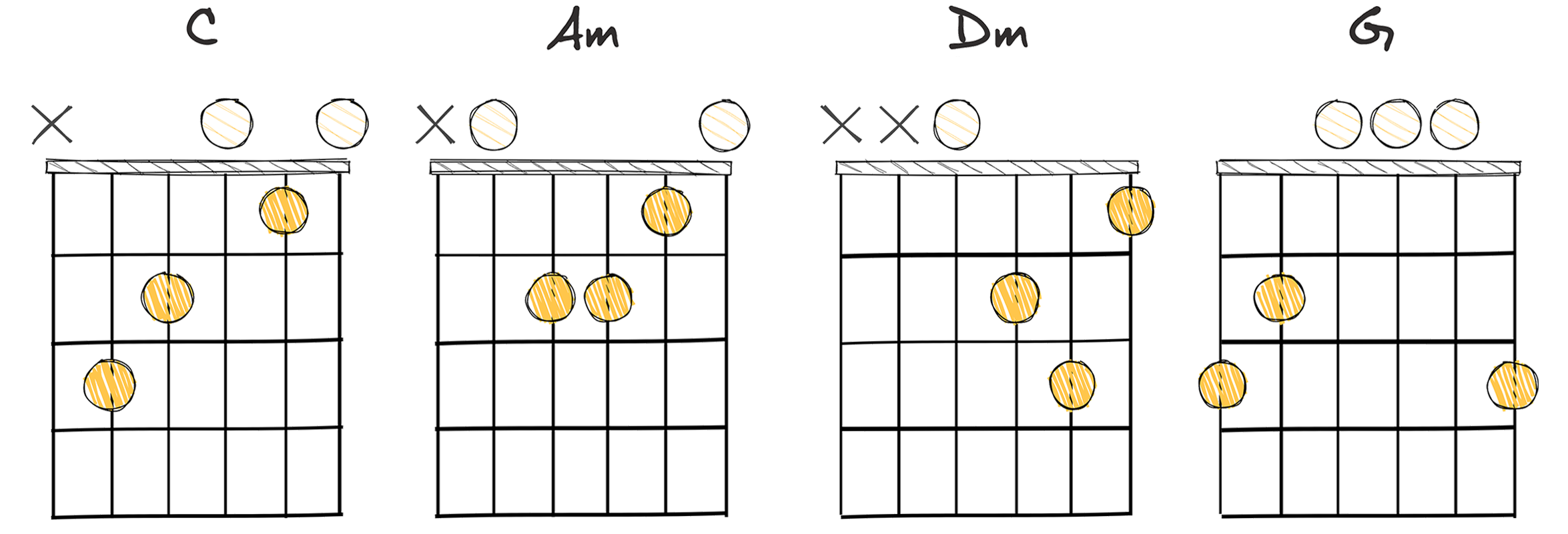
Turn your attention to the I-vi-ii-V (1-6-2-5) chord progression.
This is a chord sequence you’ll frequently encounter in many different genres of music, so it should be considered a must-know progression for any budding musician.
The progression became particularly popular in 1950s and 1960s jazz, but its influence has stretched far wider than that, showing up in pop, rock, blues, country, and other styles of music.
Its popularity likely arises from its harmonically satisfying resolution, but it is also just incredibly easy to play in virtually any key.
Being simple and straightforward, the I-vi-ii-V progression has been utilized in many timeless classics to create a signature musical appeal.
As with most progressions used in Western music, its relative simplicity hides a wealth of complexity and potential creativity.
The I-vi-ii-V progression is not only pleasing to the listener’s ear, but it also provides a solid basis for further improvisation and melody creation.
This makes it a favorite amongst songwriters and performers alike.
To play the I-vi-ii-V progression in the Key of C major, you would play the chords C (I) – Am (vi) – Dm (ii) – G (V).
In practical terms, starting with C major uplifts the progression, quickly followed by a soothing Am giving a contrasting touch.
Then proceeding to D minor gives it a slightly brooding aspect, and finally closing it with a resolving G maj chord offers a perfect conclusion to the progression.
The combination of these chords provides a satisfying musical journey within a short musical sequence.
It starts on a happy note with the C Major, moves to a more melancholic Am, introduces uncertainty with Dm, and finally resolves beautifully with G.
This resolution makes it a perfect candidate for the concluding phrase of a section, or as a repeating motif throughout a song.
The I-vi-ii-V progression has stood the test of time and is still widely used in music today, which is testament to its versatility and musicality.
Its ease of playing makes it a great starting point for beginners, but its potential for complexity also makes it a staple for experienced musicians.
Whether you’re a beginner who’s just starting to explore common chord progressions, or an experienced player looking to deepen your understanding of musical composition, understanding and mastering this progression will undoubtedly enhance your musical skills.
Learning the I-vi-ii-V chord progression is an excellent step towards broadening your musical vocabulary and becoming a more proficient musician.
This progression serves as a perfect testimony to the notion that sometimes, the most straightforward ideas, when used creatively, can create the most compelling music.
I-IV-V-vi (1-4-5-6)
This progression offers a cheerful, uplifting transition with a melancholic end.
The I-IV-V-vi chord progression is a fundamental sequence in music that can evoke a range of emotions. Prominent in a variety of genres, this progression creates a balance of tension and resolution offering harmonic richness and is essential for budding musicians to understand.
- Difficulty: Easy
- Example: G – C – D – Em (Key of G major)

Among the various chord progressions one can learn to master music making, the I-IV-V-vi progression holds a notable place.
This chord progression, based on the 1st, 4th, 5th and 6th notes of the major scale, is used in some of the most celebrated songs across genres.
Its prevalent use can be attributed to the harmonic relationship between the chords that creates a captivating and relaxing sound.
Interestingly, the I-IV-V-vi progression has a historical significance in popular music as it frequently appears in some of the most iconic classics, making it an essential progression to master.
This statement cannot be emphasized enough due to the numerous examples in the history of popular music.
From timeless rock songs to modern pop hits, the progression’s influence spans across different musical eras and styles.
This can partly be attributed to the fact that the I-IV-V-vi progression is quite easy to play, adding to its ubiquity.
As an aspiring musician, mastering this progression can be a significant stepping stone towards developing the ability to play a vast range of tunes.
The I-IV-V-vi progression, with its versatility and harmonic properties, has shaped some of the most memorable music pieces over time.
Its simplicity in playability and structure should not undermine its magnitude in forming the melodic base of a melody.
Therefore, becoming proficient in the I-IV-V-vi progression is undeniably invaluable to any musician’s musical knowledge and skill set.
IV-V-iii-vi (4-5-3-6)
A popular chord progression, creating a quintessentially smooth and modulating tune.
The IV-V-iii-vi chord progression, when played in sequence, offers a harmonious and tonally rich resonance that is commonly found in various music genres. This particular progression provides a melodious flow to a song, creating an appealing sound to listeners due to its dynamic transition from subdominant to dominant to mediant and then to submediant.
- Difficulty: Intermediate
- Example: Bb – C – Am – Dm (Key of F major)
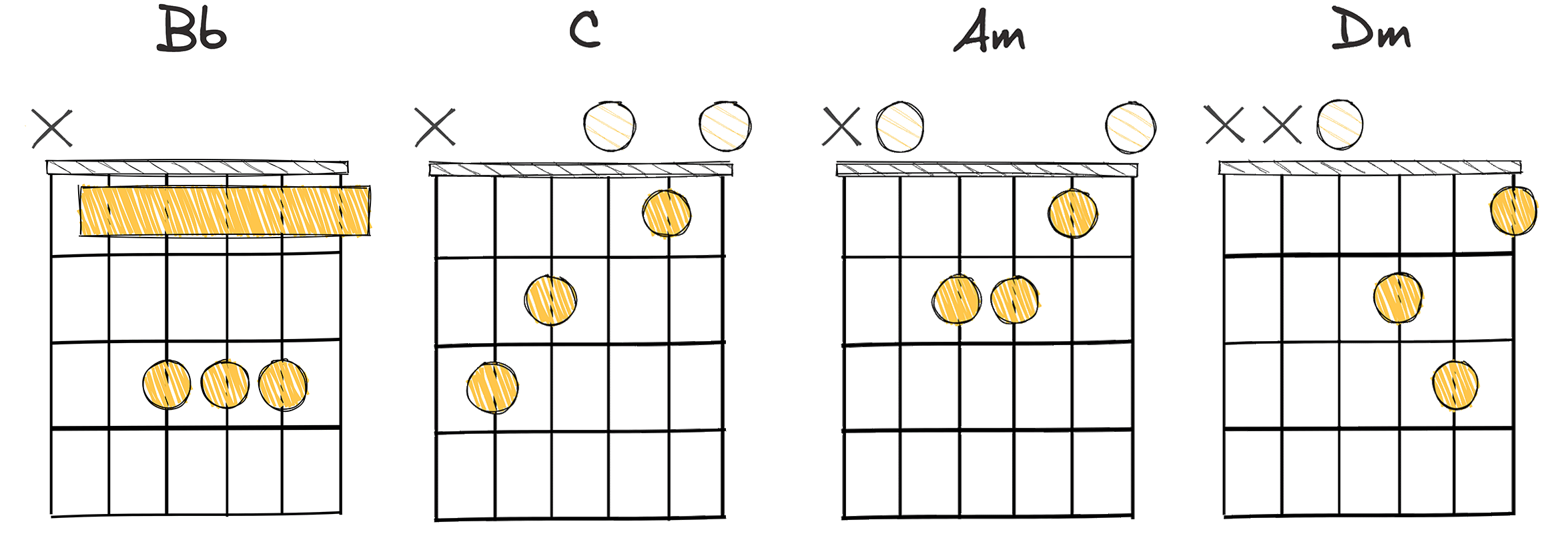
The chord progression IV-V-iii-vi (4-5-3-6) has been successfully utilized in a number of captivating songs over the years.
One thing that makes this sequence fascinating is its capacity to communicate various emotions through its harmonizations.
The progression’s utility in intermediate level compositions is specifically noteworthy.
It’s just complex enough to capture the listener’s interest, but it’s not so difficult as to deter fledgling musicians.
For those seeking to broaden their understanding of chord progressions and want to explore beyond the basics, the IV-V-iii-vi (4-5-3-6) is an excellent place to start.
Enhancing your knowledge with this chord progression is a catalyst for creativity, equipping musicians with yet another tool for their composition toolbox.
Being familiar with it expands the range of musical expression at your disposal, enabling you to convey more nuanced emotions and stories through your music.
Moreover, it’s important to highlight that this chord progression results in music that has a sense of forward momentum.
This contributes to its strength in keeping a song engaging for listeners, maintaining a sense of progression and movement.
Song examples are always a great way to understand how the chord progression works.
The chord sequence has a rich history within musical composition.
It’s been a firm favourite of composers from a wide range of different genres, showing its universal appeal and versatility.
Many musicians have sought out this progression as a way to expand their composition capabilities, applying it in a variety of ways to give their pieces a unique signature sound.
The beauty of the IV-V-iii-vi (4-5-3-6) progression is not just in its flexibility, but also in its potential for creative experimentation.
While it’s not a definitive guide to song composition, understanding this particular pattern can be a tremendously advantageous tool for any aspiring musician or songwriter.
Mastering it can greatly increase a musician’s harmonic vocabulary, leading to more diverse and engaging compositions.
As your musical journey continues, let this be a foundation stone in understanding how chords progress and interact with one another.
Expanding your understanding of chord progressions can only serve to enhance your overall musicianship skills.
I-V-vi-iii (1-5-6-3)
A popular progression with emotional pull, often used in ballads.
The I-V-vi-iii chord progression is a widely-used sequence in music, particularly within pop and rock genres. This progression creates a rich harmonic landscape, beginning with a strong, stable root chord (I), transitioning to the tension of the dominant (V), resolving into the melancholic vi chord, and finally establishing a more complex mood with the iii chord.
- Difficulty: Intermediate
- Example: C – G – Am – Em (Key of C major)
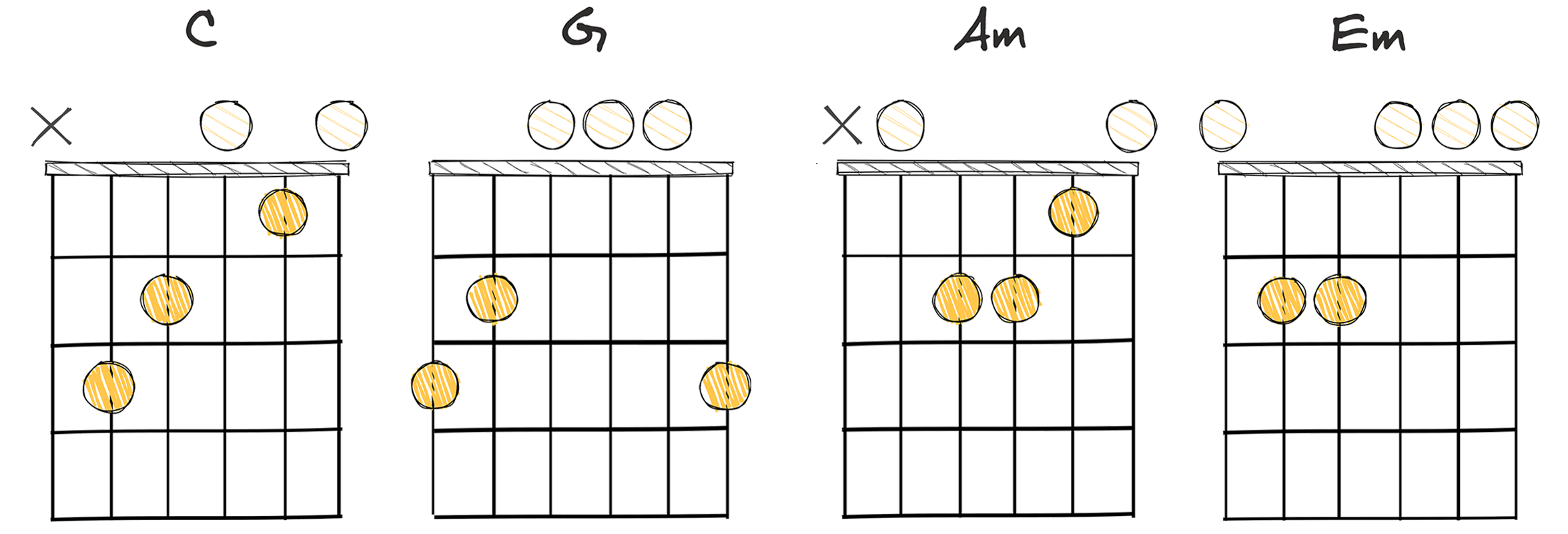
One of the common chord progressions that every aspiring musician must learn is I-V-vi-iii.
This sequence, also notated as 1-5-6-3, is considered intermediate in terms of playing difficulty.
“I-V-vi-iii” refers to the positions of the chords in a particular key.
In the key of C major, this progression would be C – G – Am – Em.
You would start on the first (I or 1), then move to the fifth (V or 5), then to the sixth (vi or 6), and finally to the third (iii or 3).
This progression has been employed in many popular songs across various genres
Its use lends a unique blend of building tension and release, a key component of memorable songwriting.
However, despite its intermediate status, it’s worth noting that mastering this progression can be a work of patience and diligent practice.
Understanding the mechanics, and being able to smoothly transition between each chord, is essential for execution.
Yet, with consistent practice, this chord progression can open up a new dimension in a musician’s skill-set and creative potential.
While I-V-vi-iii might not be as common as other chord progressions, its versatile character provides a rich opportunity for experimentation in songwriting.
Complex in structure but rich in emotional resonance, this sequence can provide an intriguing harmonic foundation for compositions.
Whether you’re a songwriter or an instrumentalist, learning these chord progressions can help elevate your musical skills and understanding.
As such, I-V-vi-iii is an essential progression to master for anyone wishing to comprehend more about the structure and harmony of modern music.
vi-ii-V-I (6-2-5-1)
Popular progression defining the backbone of countless jazz standards.
The vi-ii-V-I (6-2-5-1) progression is a classic sequence used commonly in jazz, pop, and a variety of other musical genres due to its pleasing resolution and cyclical movement. This recurring chord sequence creates a journey from a minor to a major tonality, leading to a harmonic and melodic resolution that appeals to listeners’ ears.
- Difficulty: Easy
- Example: Am – Dm – G – C (Key of C Major)
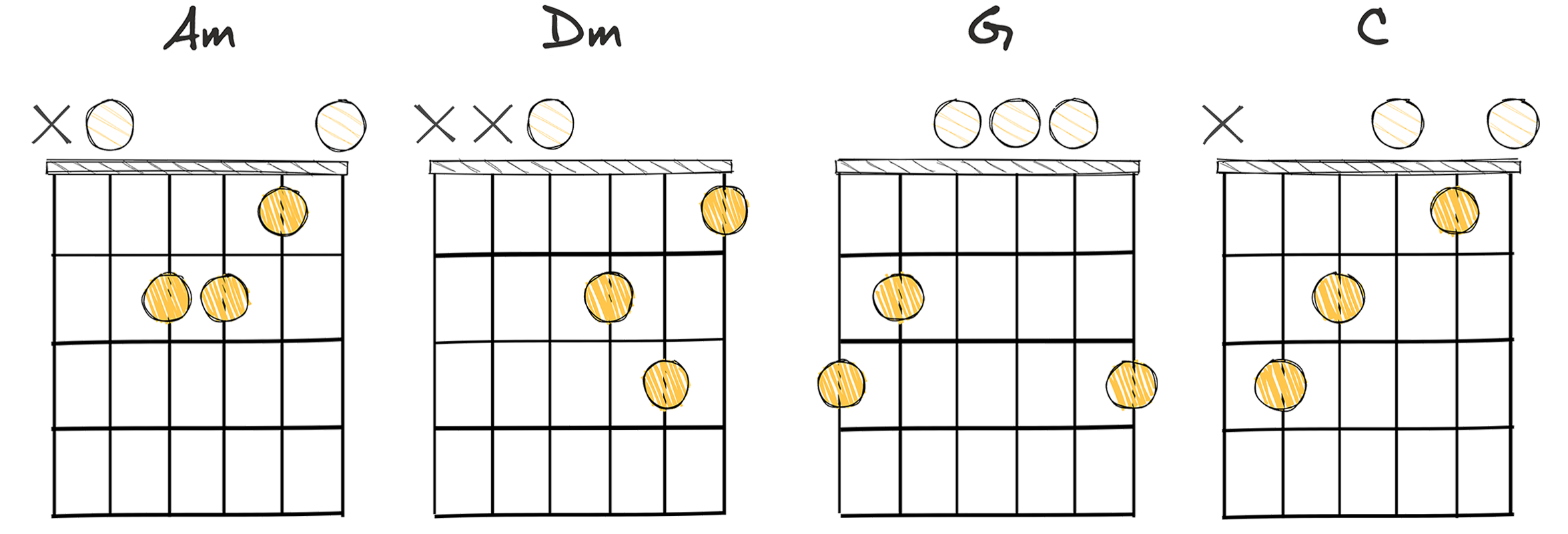
In our journey through the intricacies of common chord progressions, we arrive at section 16, highlighting the intricacy of the vi-ii-V-I (6-2-5-1) progression.
This adoption and usage of this chord progression have been evident throughout music history.
Delving into the ease of play, the vi-ii-V-I progression is not daunting for beginners to start practicing their chords transitions and harmonic flow.
Elaborately, the chord progression starts on the vi (6th degree), transitions to the ii (2nd degree), before leading to the V (5th degree), and finally resolving back on the I (1st degree).
To illustrate, in the key of A minor, the chords would be A minor, D minor, G, and C.
This progression creates a cyclic pattern that is easy to follow, allowing musicians to focus more on the rhythm and melody of the piece.
The versatility of this chord progression also allows for exploration and experimentation, providing a wide array of instruments and music genres to play with.
The vi-ii-V-I (6-2-5-1) progression is popular, not just in Jazz, but also in Pop, Rock, and other genres, thus serving as a ‘go-to’ chord progression for creators and musicians.
It would be remiss not to at least brush over the undeniable role that this chord progression has played in shaping the sound of contemporary music.
Continued exploration of this progression will reveal the depth of its potential and the possibilities it holds for musical expression.
Perhaps it’s the intricate balance between familiarity and unpredictability that makes the vi-ii-V-I progression such a ubiquitous presence in our musical landscape.
As we delve further, remember that music is a journey of discovery and every progression you learn opens up a whole new realm of creativity.
I-iii-vi-II (1-3-6-2)
A vibrant, emotional journey often employed in pop and jazz.
The I-iii-vi-II chord progression, also known as 1-3-6-2, offers a unique and pleasant sequence that is often found in a wide variety of music genres. This progression, starting from the tonic, contains mainly minor chords and provides a melancholic yet resolving feel, making it a go-to choice for songwriters for its ability to evoke strong emotions.
- Difficulty: Intermediate
- Example: C – Em – Am – D (Key of C major)

In the world of music theory and songwriting, chord progressions play a vital role in crafting memorable songs and tunes.
Specifically, we’re going to delve into the I-iii-vi-II or C – Em – Am – D progression (in the key of C major) if you prefer to go by commonly used chord notations.
This progression is widely used in pop and rock genres due to its unique combination of major and minor chords.
Notably, the change between I-iii shows an interesting transition from major tonality to minor, which often results in a slightly bittersweet sound.
With the progression embracing an intermediate level of playability, the I-iii-vi-II progression or C – Em – Am – D in the key of C major has been known to give tracks a certain spark of emotional complexity.
The transition from the iii chord to the vi chord further enhances the emotional narrative of the song, heightening the sense of melancholy or yearning, depending on the context of the song.
Meanwhile, a change from vi chord to II chord provides an intriguing sonic twist, adding more depth and variety to the musical landscape.
Now, let’s take a look at the chords in this progression from a technical perspective.
The first chord, noted as I or C in the key of C major, is a major chord
The second chord in the progression, E minor (Em or iii), provides a contrasting sound due to its minor nature.
Next is the A minor (Am or vi) chord.
As another minor chord in the progression, it carries on the melancholic sound initiated by the E minor chord.
The progression ends with the II (D major) chord, also a major chord.
This return to a major sound brings a sense of resolution, albeit a temporary one, to the otherwise predominantly minor progression.
As a result of all these factors, the I-iii-vi-II progression facilitates a musical journey that can be classified as being harmonically interesting and diverse.
It embraces varying emotional tones, which can be manipulated skillfully by songwriters and performers to create deeply resonating tracks.
To sum up, the I-iii-vi-II (C – Em – Am – D in the Key of C Major) chord progression bears a special status in music composition.
Over the years, it has proven its worth in creating countless memorable songs in various genres, giving listeners a beautiful blend of major and minor tones.
Considering its versatility and emotional depth, learning and mastering this chord progression is undoubtedly beneficial for any budding songwriter or musician who aspires to create compelling and sophisticated music pieces.
IV-V-I-IV (4-5-1-4)
A classic, resolution-rich progression favored in pop and rock music.
The IV-V-I-IV progression is a classic and common chord sequence, often used in a variety of music genres due to its pleasing resolution from the dominant (V) to the tonic (I). This progression creates a cyclical sound that can effectively drive a melody, providing a solid foundation for many famous songs.
- Difficulty: Easy
- Example: F – G – C – F (Key of C major)

The IV-V-I-IV progression is a fundamental component of numerous musical genres and has a rich historical background.
Originating from the rules of classical tonal music, this progression has been a staple in music production for centuries.
In the Classical period, the progression may have been more commonly reversed as I-IV-V-I.
The IV-V-I-IV progression gained notable popularity with the birth of blues and rock and roll in the 20th century.
This statement holds significant weight as these two genres came to define the music of the century and seeped into the realms of pop and contemporary music.
The progression’s straightforward structure and pleasing resolution made it a go-to formula for songwriters and musicians.
One of the key reasons why it became so favored is because it’s easy to play.
This progression typically involves moving just one or two fingers to change chords, making it accessible even to budding guitarists and pianists.
In the key of C major, this progression would be represented by the chords F – G – C – F.
These chords flow seamlessly together, lending a sense of completeness and resolution to any piece they’re used in.
The IV-V-I-IV progression’s historical background, ease of play, and versatility contribute to its widespread use and continued prevalence in modern music.
Understanding this progression can function as a stepping stone for both listeners and musicians alike, opening doors to deeper appreciation and comprehension of music.
However, it’s crucial to remember that a chord progression is only one aspect of a song.
While they can provide structure and foundation, it’s the inspired use of other compositional elements that make a piece of music truly come to life.
I-V-ii-IV (1-5-2-4)
A foundational progression, I-V-ii-IV adds uplifting movement to any composition.
The I-V-ii-IV progression is a fundamental, four-chord pattern found frequently in popular music across various genres, offering a smooth transition between the tonic note, dominant, supertonic, and subdominant. It has an uplifting sound known for creating resonance and harmony, making it a great choice for songwriters who wish to elicit strong emotional responses from their listeners.
- Difficulty: Easy
- Example: C – G – Dm – F (Key of C major)
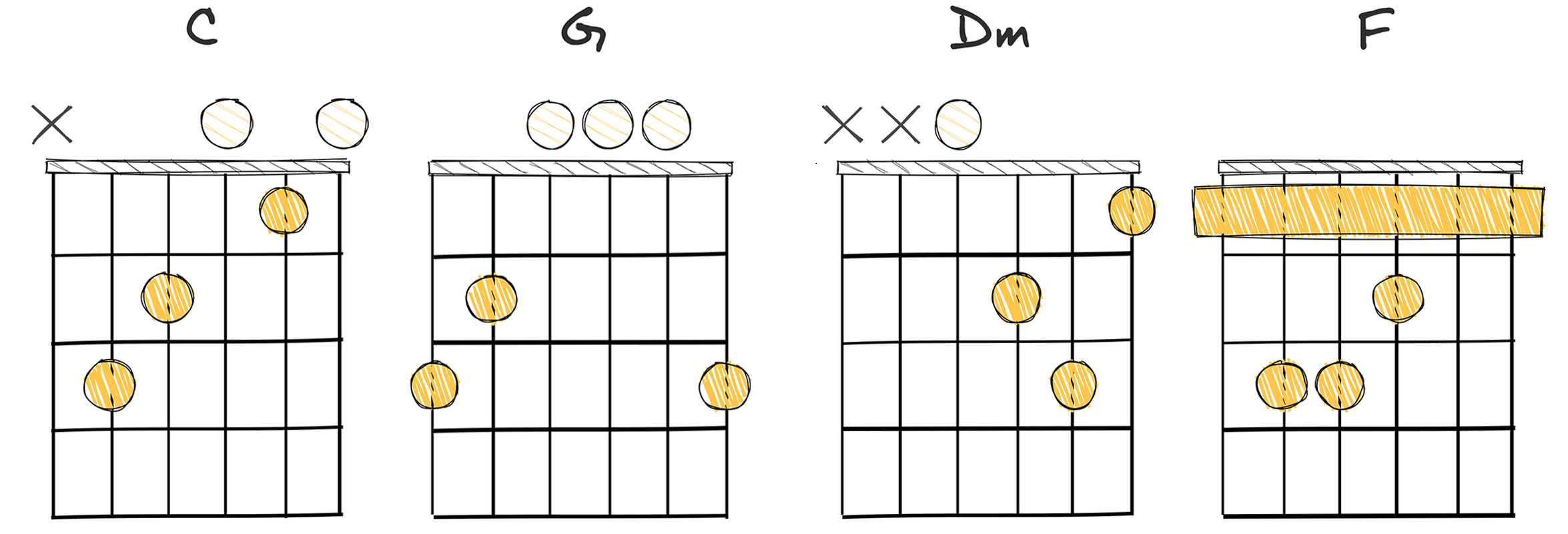
The I-V-ii-IV (1-5-2-4) chord progression stands as a highly popular and fundamental progression in the realm of music, contributing to its enriched history and usage.
This particular progression, similar to many others, is easy to play and versatile across a range of genres, offering a melodious and harmonious sound that resonates with listeners.
The I-V-ii-IV progression is a modification of the conventional I-IV-V progression, indicating an interesting shift towards the ii (2) chord instead of the common return to the I (1) chord after the V (5) chord.
It’s a powerful progression that generates an endless loop feeling, compelling the music to keep moving forward.
The progression’s composition and structure favorably complement the melodic elements of a song, providing a sonic backdrop that accentuates the rhythmic patterns and lyrical content.
Furthermore, the progression’s pattern of varying major and minor chords is key to its appeal, enabling a vast spectrum of tonal possibilities when composing music.
Therefore, the relative simplicity and versatility of the I-V-ii-IV chord progression renders it an essential tool in a musician’s toolkit.
As such, mastering this chord progression is paramount for young musicians aspiring to hone their craft, given its recurrent usage and profound influence in the music industry.
While understanding the theoretical foundation of this music progression is invaluable, the real charm lies in its application- contributing to its fun and easy-to-play nature.
I-vi-iii-IV (1-6-3-4)
A staple in pop music, blending sequence with subtle resolution.
The I-vi-iii-IV progression is a widely used chord sequence in many genres of music, and is noted for creating a deeply melodic and harmonic sound. This progression, comprised of major and minor chords, begins on the tonic (I) and moves to the relative minor (vi), followed by the mediant (iii), and concludes with the subdominant (IV), creating an emotional and resonant musical journey.
- Difficulty: Easy
- Example: C – Am – Em – F (Key of C major)
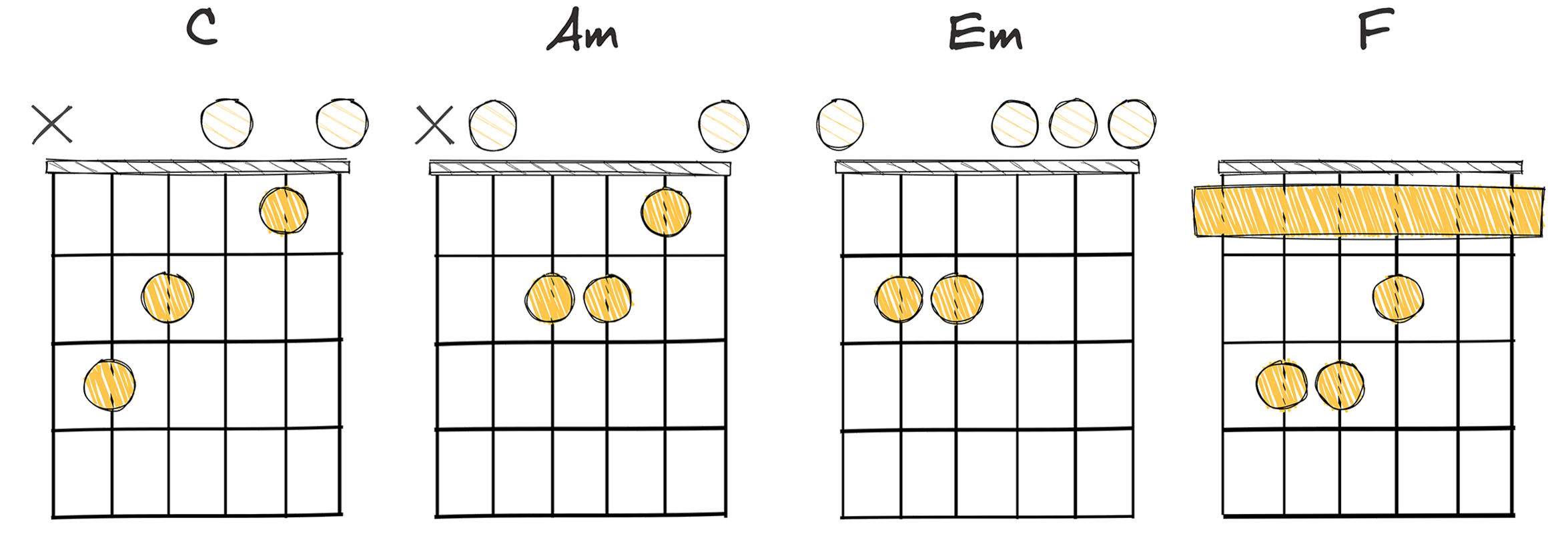
The chord progression I-vi-iii-IV (1-6-3-4) is an incredibly popular sequence in the realm of music, especially in the genre of pop music.
When we talk about the history of this progression, it is paramount to note that it is inspired by the musical creations of the Baroque, Classic, and Romantic periods.
Throughout the years, composers have found its natural flow and melodic transition to be appealing and easy to incorporate into various compositions.
Despite its extensive history, it continues to be highly revered and considered a modern progression.
The simplicity of the I-vi-iii-IV progression makes it an ideal choice for novice players, allowing them to explore the world of music without feeling overwhelmed.
Within the Key of C Major, this chord progression translates to C – Am – Em – F.
The progression proceeds from the tonic chord (C), moves to the submediant (Am), then to the mediant (Em), and finally to the subdominant (F).
This particular sequence provides an easy flow of chords, ensuring a harmonious blend of sounds that is pleasing to the ear.
The I-vi-iii-IV progression is a fundamental element of many songs in Western music, highlighting its enduring relevance and the ongoing need to master it.
As a musician, understanding this progression will provide a solid foundation for composing your own music
IV-V-I-vi (4-5-1-6)
A quintessential base for countless pop and rock ballads.
The IV-V-I-vi chord progression is a staple in a variety of musical genres, often used for its satisfying resolution and emotional depth. Known for its classic major-tonic resolution (I chord), the addition of the vi chord gives the progression a little twist of melancholy, giving it a versatile and engaging sound.
- Difficulty: Easy
- Example: F – G – C – Am (Key of C major)
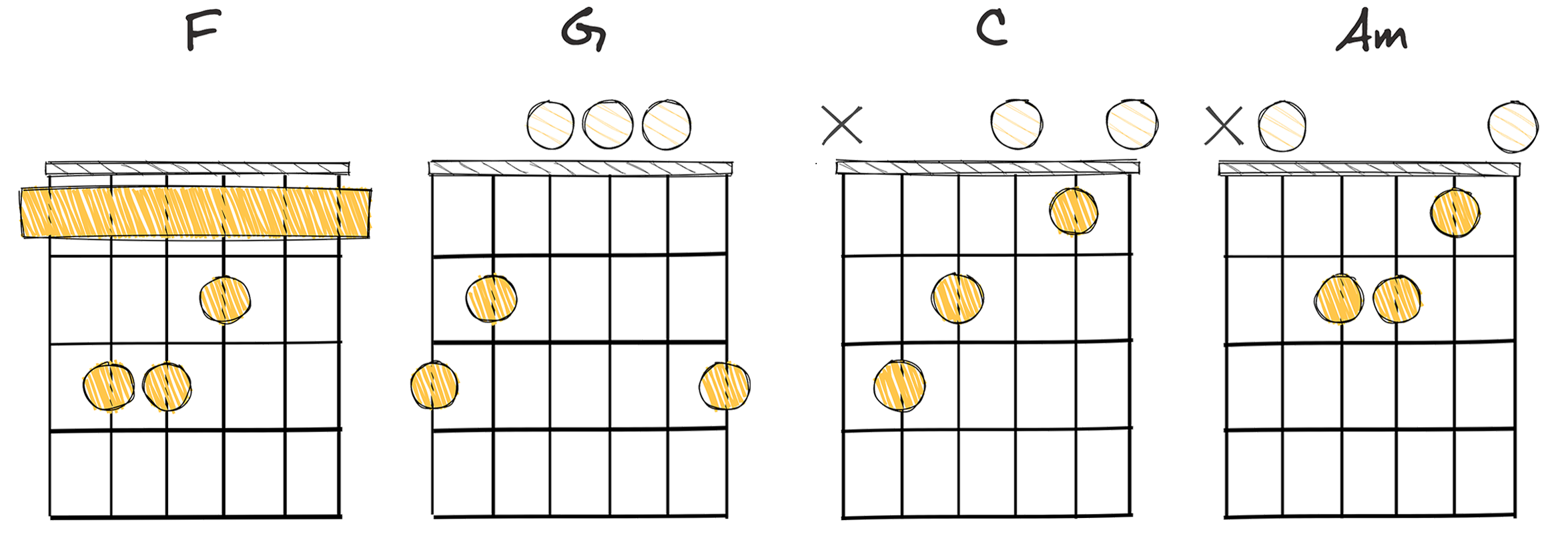
The IV-V-I-vi chord progression, numerically represented as 4-5-1-6, is an essential structure in music that broadly enriches the harmonic language of a song.
This chord progression holds a rich history in music, as it has been broadly used in multiple genres ranging from classical music to modern pop and rock.
Often, composers and songwriters rely on the IV-V-I-vi to create a sense of resolution and then introduce some degree of tension by culminating on the vi chord, which is usually a minor chord in a major key.
This subtle contradiction imparts a unique emotional flavor.
This tactic of tension and resolution is nothing new; it’s been the binding force of most music compositions over the centuries.
Since the IV-V-I-vi (4-5-1-6) is an easy chord progression to play, it’s favored by musicians of all skill levels.
This progression’s simplicity allows musicians to focus more on their musicality, dynamics, and presentation rather than getting burdened by complex fingerings.
Specifically, in the key of C major, these chords correspond to F major (IV), G major (V), C major (I), and A minor (vi).
When rearranged, they give us a progression of F – G – C – Am.
It’s important to note that while this progression is easy to learn and play, it’s the musicians’ interpretation, and courtship of these chords that can make a song stand out uniquely.
Therefore, even with simplicity lies the opportunity for expressive sophistication.
The IV-V-I-vi progression is almost like a canvas, and musicians are the artists that bring it to life with their colors and brushstrokes.
The Bottom Line
The aforementioned sequences represent the most commonly used chord progression in numerous musical genres.
These harmonic combinations, deriving from a seven-note scale, serve as the underlying backbone that gives a song its particular character and feel.
With a total of twenty-one examples provided, it’s evident that these progressions offer limitless potential for composers and songwriters, allowing creativity and expressiveness while still maintaining a structural framework.
Despite their similar numerical representation, each progression offers a unique auditory experience.
Understanding and utilizing these chord sequences continues to be a crucial component in effective songwriting and arrangement, ensuring a certain level of familiarity and resonance with listeners while offering an opportunity for inventive crafting of music.
In love with guitars, and gear; expert in all things music! Been writing about guitars for about 5 years and counting. Born in the ’90s. Alma Mater: University of Havana. Always curious, trying to understand the world. #TeamFender



